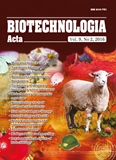ISSN 2410-7751 (Print)
ISSN 2410-776X (Online)

"Biotechnologia Acta" V. 9, No 2, 2016
https://doi.org/10.15407/biotech9.02.048
Р.48-54 , Bibliography 13, English
Universal Decimal Classification: 577.158.54
O. V. Gudzenko, N. V. Borzova, L. D. Varbanets
Zabolotny Institute of Microbiology and Virology of the National Academy of Sciences of Ukraine, Kyiv
The aim of the research was a comparative study of the thermal stability of native and modified by various methods α-L rhamnosidases of Eupenicillium erubescens and Cryptococcus albidus for improving the stability of enzymes. Denaturation of native and modified enzymes were performed at 65 0C, pH 5.2. Enzyme activity was determined using p-nitrophenyl-α-L-rhamnopyranoside and naringin. It is found that in the treatment by polyethylenglycol PEG 1500, dextrans 500 and 70 T thermostability of α-L-rhamnosidases tested decreases, while modification with polyethylenglycol 20000 leads to increase thermal stability of the E. erubescens enzyme to 280% and C. albidus to 150%. Comparative study of the thermal stability of the native and modified by cellulose and its derivatives α-L-rhamnosidases of C. albidus and E. erubescens showed that at concentrations cellulose of 5–15 μg/10 μg protein protective effect of polymers on enzymes was investigated was observed. Hydrophobic modifications using succinic anhydride also can slow down the denaturation of α-L-rhamnosidases tested under experimental conditions. These stabilized C. albidus and E. erubescens α-L-rhamnosidases can be used in biotechnological processes.
Key words: α-L-rhamnosidase, Eupenicillium erubescens, Cryptococcus albidus, thermal stabilization of enzymes.
© Palladin Institute of Biochemistry of the National Academy of Sciences of Ukraine, 2016
References
1. Manzanares P., Valles S., Ramon D., Orejas M. ?-L-Rhamnosidase: old and new insights. Industrial Enzymes. Polaina J., MacCabe A. P. (Eds.). Springer. 2007, 117–140. http://dx.doi.org/10.1007/1-4020-5377-0_8
2. Gudzenko O. V., Varbanets L. D. Component composition of Cryptococcus albidus and Eupenicillium erubescens a-L-rhamnosidases. Microbiol. Zh. 2014, 76 (5), 11–15. (In Ukrainian).
3. Gudzenko O. V., Borzova N. V., Varbanets L. D. Influence of metal ions and specific chemical reagents on the a-L-rhamnosidase activity of Eupenicillium erubescens. Ukr. Biokchim. Zh. 2012, 80 (2), 30–41. (In Russian).
4. Gudzenko O. V., Varbanets L. D. Investigations of functional groups of Сryptococcus albidus ?-L-rhamnosidase. Microbiol. Zh. 2012, 74 (4), 19–28. (In Ukrainian).
5. Gudzenko O. V., Varbanets L. D. Purification and physico-chemical properties of Cryptococcus albidus 1001 a-L-rhamnosidase. Microbiol. Zh. 2012, 74 (6), 16–23. (In Russian).
6. Varbanets L. D., Gudzenko O. V., Borzova N. V. Rhamnosidase from Eupenicillium erubescens: purification and characterization. Nauka i studia. 2013, 41 (109), 11–23.
7. Romero C., Manjon A., Bastida J. A method for assaying rhamnosidase activity of naringinase. Anal. Biochem. 1985, 149(2), 566–571. http://dx.doi.org/10.1016/0003-2697(85)90614-1
8. Davis D. W. Determination of flavonones in citrus juice. Anal. Biochem. 1947, 19 (1), 46–48.
9. Trofimova D.N, Kamyshny A. L, Magdassi S., Levachev A.V. Effect of chemical modification on stability of glucose oxidase and formate dehydrogenase. Vestnik Moskowskiy Universitet Khimiia. 2003, 44 (1), 48–52. (In Russian).
10. Kharlov А. Е., Anischyk А. N., Derkach S. R., Levachev S. M. Interaction between bovine serum albumin and amphiphile molecules of different type. Vestnik VSGTU. 2012, 3 (38), 81–89. (In Russian).
11. Vinogradov A. A., Kudryashova E. V., Grinberg V. Ya., Grinberg N. V., Burova T. V., Levashov A. V. The chemical modification of ?-chymotrypsin with both hydrophobic and hydrophilic compounds stabilizes the enzyme against denaturation in water–organic media. Protein Eng. 2001, 14 (9), 683–689. http://dx.doi.org/10.1093/protein/14.9.683
12. Ellman G. Tissue sulfhydryl groups. Arc. Biochem. Biophys. 1959, 82 (1), 70–77. http://dx.doi.org/10.1016/0003-9861(59)90090-6
13. Lakin G. F. Biometrics. M.: High School. 1990, 325 p. (In Russian).
14. Borzova N. V., Varbanets L. D. Use chemical modification methods for stabilization of fungal glycosidases. Biotekhnolohiia. 2011, 4 (6), 36–41. (In Russian).
15. Kashpur N. V., Martinov A. V., Volyanskiy A. Yu., Peremot S. D., Smelyanskaya M. V. Chemical modification of high molecular medications. Annals of Mechnikov Institute. 2010, N 3, P. 9–21. (In Ukrainian).

